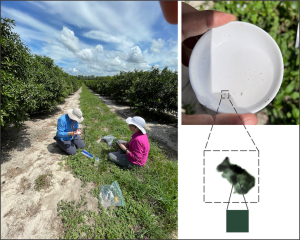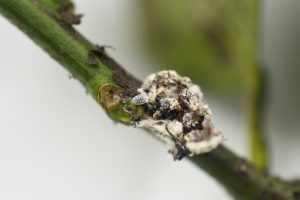
FORT PIERCE, Fla.— Florida citrus and nursery growers need to develop proactive management plans for Lebbeck mealybug, an invasive pest that can cost the fruit and ornamental industries thousands of dollars in damages to fruit trees and landscaping plants.
A team of research scientists is working to prevent such scenarios with an early diagnostic kit to identify the invasive mealybug on trees and nursery plants. The insect is hard to detect and identify during its early life stage because it is so tiny that it is often concealed in small crevices in plants.
The Lebbeck mealybug: One of the most common regulatory pests in the United States
“Mealybugs are among the most common regulatory pests in the United States, especially in Florida,” said Dr. Nicole Quinn, assistant professor and research entomologist at the UF/IFAS Indian River Research and Education Center (IRREC) in Fort Pierce, Florida.
“This kit can easily be used in the field by researchers and growers alike to rapidly determine if the mealybug that they are looking at is in fact Lebbeck mealybug. It will be useful in my classical biological control research program, which aims to locate natural enemies of Lebbeck mealybug in its native range,” said Quinn.
Grant from the Florida Nursery, Growers & Landscape Association
Quinn and a research team of mealybug experts won a grant from the Florida Nursery, Growers & Landscape Association to share their kit with nursery stakeholders and distribute the kits to nursery owners, managers and growers. Dr. Quinn, Dr. Lance Osborne, an entomologist at the UF/IFAS Mid-Florida Research and Education Center in Apopka, Florida, and Dr. Muhammad “Zee” Ahmed, a research entomologist with the United States Department of Agriculture Agricultural Research (USDA-ARS) Horticultural Research Laboratory in Fort Pierce, work with a sense of urgency to teach agriculturalists how to use them in the fields and greenhouses.
“I applaud the researchers in their work to develop the Lebbeck mealybug diagnostic kit so rapidly,” said Dr. Ronald D. Cave, director of IRREC. “The team of entomologists has forgone efforts to seek a patent on the kit to prioritize immediate needs for the industry they serve.”

Dr. Quinn said, “Florida is vulnerable to invasive species, and we want to give the growers this tool before we have a problem that impacts the ability of our growers to export their fruit.”
Workshop for nursery stakeholders
Dr. Quinn’s team is offering a workshop for nursery stakeholders on Tuesday, April 25, from 9 a.m. to noon at the UF/IFAS-IRREC, located at 2199 South Rock Road. Those who wish to participate may sign up at this link.
The Lebbeck mealybug (Nipaecoccus viridis) is easy to miss when young. In citrus groves, a sign of an infestation is deformed fruit, often leading to high levels of fruit drop. “The diagnostic kit will help growers distinguish between the Lebbeck mealybug and other mealybugs, such as citrus mealybug, coconut mealybug, long-tailed mealybug, Madeira mealybug, papaya mealybug, pink hibiscus mealybug, solanum mealybug, and solenopsis mealybug,” Dr. Ahmed said.
The Lebbeck mealybug is native to Southeast Asia, where it is called the spherical mealybug. “In ornamental plants such as oleander and jatropha, its heavy infestations are associated with leaf distortions, crinkling, and discoloration due to excessive feeding and reproduction,” said Dr. Ahmed. “In addition, it excretes sticky honeydew leading to the growth of black sooty mold on the leaf surfaces, which reduces the plant photosynthesis, growth, and ultimately its aesthetic values in the landscape,” Dr. Ahmed said.
Lebbeck mealybug diagnostic kit
“We have found a reagent that reacts with the mealybug and positively identifies a Lebbeck mealybug when it turns green,” said Dr. Ahmed. “The kit includes a dropper bottle with a reagent inside and a fabric that looks similar to a paper towel.”
The team will teach nursery growers to scout for the purplish-red young “crawler” mealybugs, crush them on a piece of kit paper, and then apply the dropper solution to the crushed mealybug body when placed on the kit paper.
“If the crushed body of a mealybug turns green—it’s a Lebbeck mealybug,” said Dr. Ahmed.
Dr. Ahmed developed the diagnostic kit along with a co-author, Lily Deeter, in an article published in the Journal of Applied Entomology and is collaborating with Dr. Quinn, Dr. Osborne, Christina Dorado, a research chemist with the USDA-ARS Horticultural Research Laboratory in Fort Pierce, and Dr. Lauren Diepenbrock, assistant professor and research entomologist at the UF/IFAS Citrus Research & Education Center (CREC), Lake Alfred to enhance the scope of this kit.
“Mealybug species are almost impossible to differentiate at the crawler stage in the field,” said Dr. Ahmed. “The diagnostic kit will be the first in the world to identify the Lebbeck mealybug in the field so that growers can distinguish it from other common mealybugs during pest scouting,” said Ahmed.
“This is important to ornamental growers because it allows them to identify and manage infested plant materials. If producers can identify the mealybug, they can dispose of the infested plants without having to quarantine their entire field or crop,” Dr. Osborne said.
Dr. Quinn said invasive plants and insects are prevalent in Florida. But, scientists, citizen scientists and gardeners are becoming increasingly aware of invasive plants and insects and how to manage them. The increased awareness powers more community-wide pest management strategies and public interest to join the fight against invasive species.
“Growers, gardeners, and others who move plant material from one location to another can help prevent Lebbeck mealybug spread and infestation by being aware of what is in their plants,” said Dr. Quinn. “We can all play an important role in protecting Florida’s landscapes from invasive species.”
 18
18
